On the matter of mutuality, the USA needs India to meet its strategic goals, as New Delhi wants relations with the US to grow for the purposes of security and economic development
 Dr. D.K. Giri I INFA Service
Dr. D.K. Giri I INFA Service

The White House Press Secretary Jen Psaki outlined the US agenda on India in 2022 in her daily news briefings to the media on 10 January. She said India and US are going to move on with a range of new initiatives on issues facing the world. She named: greater cooperation in fighting the pandemic, enhancing efforts on climate change, strengthening Quad, dealing with cyber and new technologies, expanding trade and investment.
Ms Paski asserted that the 2022 agenda stems from the meeting of President Joe Biden, and Prime Minister Narendra Modi in September 2021. They had agreed to “launching a new chapter in the history of US-India relationship”. She added that the shared vision of India-US relationship was laid out in that meeting, and they will begin to put it into action this year.
Talking about India, as before, she reiterated the commitment to deepening the ties that are underpinned by the shared democratic values. To talk about shared democracy has become rhetorical, but identifying the substance and structure of the relationship in her formulation is in order.
The most important variable component of India-US relations is the role of China vis-à-vis both countries. While China is challenging the US in economic supremacy, it is being aggressive against India on its borders. In India-US bilateral relations, the attitude of the US towards China is invariably asked. So it was in the press conference addressed by Ms Paski. In response, she said that the United States is carefully watchful, “we continue to closely monitor the situation. We continue to support dialogue and peaceful resolution of these border disputes”.
In addition to the normal diplomatic answer, she asserted that Washington is concerned about Beijing’s behaviour in the world, which has a destabilising consequence. Also, its military manoeuvres are aimed at intimidating its neighbours. The USA is consciously concerned about it and is committed to supporting and protecting its partners. That is a reassuring statement made by the US spokesperson.
From the US point of view, India’s relations with Russia could be an irritant. India is the founding member of non-alignment maintained closer ties with the Soviet Union during the cold war and now Russia for military supplies. In October 2019, India agreed to purchase Russia’s S-400 anti-aircraft missile system and has received the first set of deliveries. The Countering America’s Adversaries Through Sanctions Act (CAATSA) may sanction India for this deal, as NATO member Turkey found out last year when it was sanctioned. The Trump administration had cautioned India that it was unlikely to get a waiver from the law. If the Biden Administration would be more liberal, we will have to wait to find out.
On the part of India, the US needs to focus on building India as a major economy to enable her to stand up to China. It is no secret that the US is building coalitions of countries to counter China, be it QUAD or AUKUS. But Washington cannot make military alone the key to building anti-China coalitions. Trade has to be equally important. China quietly built its economy, ironically, with the help from America and Europe and now is flexing its military muscles. That is the way to go. A sound economy is a prerequisite to building strong security machinery. This trajectory could not be lost on diplomats or military strategists. In keeping with this premise, it may be worth our while to assess the US-India relations.
In many ways, India-US relations could address many emerging issues in the world — from restructuring supply chains including creating smaller and multiple ones, dealing with climate change, security challenges mainly in the India-Pacific area. But the trade between both countries must grow in tandem with the centrality of bilateralism. That is the key to a robust partnership between the big democracies of the world. There is an urgency to this and hopefully, leadership in both countries realise this. On the contrary, slow progress in trade and commercial relations will hold back other strategic objectives envisaged jointly.
It may be noted that the long-standing disagreements over critical issues and lack of structural trade agreements between the countries have held back the realisation of the full perceived potential of the relationship. Experts and observers feel that a closer partnership between India and the US is desirable, but inexplicably, the progress is disappointingly slow. As countries across the world reconsider their trade and investments strategies, India and US should hit the commonly aspired goal of $500 billion in two-way trade. Agree that, the trade has grown more than 10 times in the last 20 years or so, but it is not enough for a partnership that seeks to be the main axis of global governance.
In near future, India will be emerging as the fastest, youngest and biggest market. It is being seen to be overtaking Japan in a few years and become the third-largest economy. The business in the United States see this possibility and wish to relocate to the Indian market. India has also shown greater interest than before in a broader trade agreement. But it has restrictive investment and regulatory policies which multinational companies are not comfortable with. The United States will like a deeper trade relationship but will like these restrictions to be eased. For instance, The Indian government’s moves to raise FDI caps and repeal the retroactive taxes has boosted the confidence of American companies.
Indian bureaucracy remains conservative and un-cooperative to business in general, and to the overseas companies in particular. It is one thing to invite investment, it is another to make the investors feel at home. No wonder, the former chief of Alcatel instructively remarked, “Indian has wonderful people, but is a terrible market.”. When can we dispel this perception?
On the matter of mutuality, the USA needs India to meet its strategic goals, as New Delhi wants relations with the US to grow for the purposes of security and economic development. There are differences in trade matters. But for both countries to forge a partnership, it is important not to focus on the differences, but to work on potential alignment of interests and emerging opportunities. The US should appreciate India’s need for growth and development, whereas India should have a predictable and accommodative regulatory environment that will draw greater investment.
On a larger point, as the US desires to organise and unite the democracies in the world, at the time of geopolitical flux in the face of challenges from autocracies like China, Russia and smaller ones like North Korea, Syria and so on, a greater partnership with the largest democracy of the world will be a good starting point. For a change, the leadership both in Washington and New Delhi should allow and facilitate the companies to co-create the trade opportunities and help drive the partnership. —INFA
Advertisements | 5E For Success

Join KRC Career Membership Program
KRC Career Membership Program is the first step towards an evolved career-building support system powered by KRC Foundation.
Ideal for students and job seekers.
Mail resume to- 5eforsuccess@gmail.com WhatsApp: 9531090090





